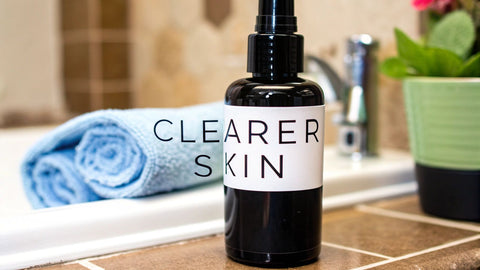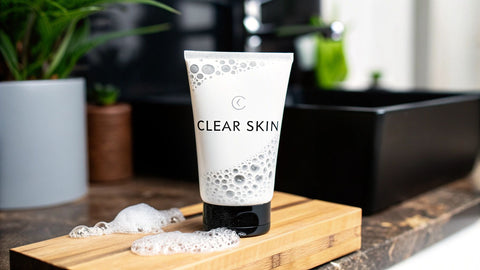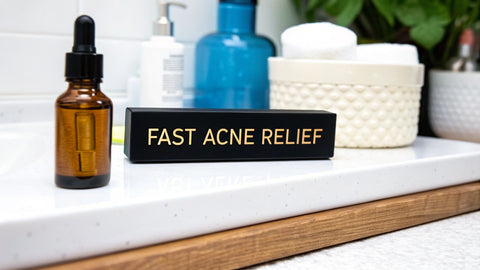Sulfur vs Benzoyl peroxide: Your Expert Guide to Acne Treatment

When choosing between sulfur and benzoyl peroxide for acne, the biggest difference boils down to how they work and their intensity. It’s a classic case of power versus patience. Benzoyl peroxide is a fast-acting powerhouse that kills acne-causing bacteria head-on, ideal for stubborn, inflamed pimples. On the other side, sulfur takes a gentler, more well-rounded approach by managing oil and exfoliating, making it a go-to for sensitive, oily, or even rosacea-prone skin. As leaders in effective acne care, we at Neutralyze believe that understanding these key ingredients is the first step toward achieving lasting clarity.
The Core Differences: How They Actually Work

Picking the right acne ingredient can feel overwhelming, but it gets much easier once you understand what each is designed to do. Both benzoyl peroxide and sulfur are trusted over-the-counter staples, but they target different skin types and acne concerns. Getting to know their unique mechanisms is key to building a routine that actually works for you. At Neutralyze, our expertise is built on a deep scientific understanding of how these ingredients perform, allowing us to guide you toward the best solution.
Benzoyl Peroxide: The Bacteria Killer
Think of benzoyl peroxide as a targeted weapon. Its claim to fame is its potent bactericidal action. It works by introducing oxygen into your pores, which creates a hostile environment for the main acne-causing bacteria, Cutibacterium acnes (formerly P. acnes). The bacteria simply can't survive. This direct, aggressive attack is what makes it so effective against red, angry, and inflamed breakouts.
Sulfur: The Gentle Regulator
Sulfur, on the other hand, plays a different game. It’s less about brute force and more about creating a balanced environment. Its main strengths are its keratolytic and oil-absorbing properties. As a keratolytic, it helps dissolve the 'glue' that holds dead skin cells together, allowing them to shed more easily and preventing them from clogging pores. Combine that with its knack for soaking up excess oil, and you have an excellent ingredient for maintaining clear skin over the long haul.
The Bottom Line: Benzoyl peroxide is your heavy hitter for active, inflamed breakouts because it wipes out bacteria fast. Sulfur is the gentler manager, working behind the scenes to control oil and prevent clogs, making it a much safer bet for sensitive skin or for long-term use.
To put it all in perspective, here's a quick cheat sheet comparing the two.
Quick Look: Sulfur vs. Benzoyl Peroxide
| Attribute | Sulfur | Benzoyl Peroxide |
|---|---|---|
| Primary Action | Keratolytic (exfoliates) & regulates oil | Bactericidal (kills bacteria) |
| Best For | Mild acne, blackheads, whiteheads | Moderate to severe inflammatory acne (pustules & papules) |
| Ideal Skin Type | Sensitive, oily, and rosacea-prone | Oily, combination, and resilient skin |
| Potential Side Effects | Mild dryness, that classic "sulfur" smell | Significant dryness, peeling, redness, and irritation |
This table gives you a bird's-eye view, but the real magic is in knowing which one fits your specific situation. One offers a powerful, fast-acting solution for painful breakouts, while the other provides a sustainable, gentle path to clarity. At Neutralyze, we're all about empowering you with the knowledge to make the right call for your skin's unique needs.
How Sulfur Gently Works to Clear Acne

If benzoyl peroxide is a direct assault on acne bacteria, sulfur takes a more nuanced, multi-pronged approach to bring your skin back into balance. It’s widely known for being a much gentler option, which is why it’s often the first stop for people with sensitive or easily irritated skin.
Sulfur's main claim to fame is its keratolytic properties. That’s a sophisticated way of saying it helps your skin shed its outer layer of dead cells more effectively. By dissolving the "cement" that holds those old cells together, sulfur prevents them from piling up and clogging pores—essentially stopping a breakout before it starts.
This gentle exfoliation is a game-changer for preventing blackheads and whiteheads, which are simply plugs of oil and dead skin. Keeping pores clear creates an environment where acne can’t get a foothold.
Taming Oil and Keeping Bacteria in Check
Beyond just clearing out dead skin, sulfur is a brilliant regulator. It naturally absorbs excess sebum (oil) right off the skin's surface. If you have oily or combination skin, you know what a difference that can make in reducing the shine and greasy feeling that often accompanies breakouts.
While it’s not the bacterial powerhouse that benzoyl peroxide is, sulfur does have mild antibacterial and anti-inflammatory effects. It slows down the growth of C. acnes bacteria and helps calm the redness and swelling that make pimples so noticeable.
Key Insight: Sulfur’s triple-action approach—exfoliating dead skin, soaking up excess oil, and soothing inflammation—makes it a uniquely balanced way to manage mild to moderate acne without causing more irritation.
And people have definitely noticed how reliable it is. The global market for sulfur beauty products was valued at roughly USD 2.8 billion in 2023 and is expected to climb to USD 5.1 billion by 2033. This growth underscores just how trusted it has become as a go-to acne fighter. You can find more insights on sulfur's rising popularity over at datahorizzonresearch.com.
Who Is the Ideal Candidate for Sulfur?
So, who really stands to benefit from this gentle giant? Sulfur is a perfect match for certain skin types and concerns, especially when more aggressive treatments might just make things worse.
- Sensitive Skin: If your skin flares up with redness, flaking, or irritation at the drop of a hat, sulfur is an effective alternative that won’t provoke a harsh reaction.
- Oily and Combination Skin: Its oil-absorbing talent helps keep shine under control without stripping your skin of its necessary moisture.
- Mild Acne: It excels at treating non-inflammatory acne like blackheads and whiteheads, along with the occasional mild pimple.
- Rosacea-Prone Skin: Thanks to its anti-inflammatory nature, dermatologists often suggest sulfur-based products for people dealing with both acne and rosacea.
When you look at how it works, it’s obvious that sulfur is far more than just some old-fashioned remedy. It’s a scientifically backed ingredient that offers a gentle, effective route to clearer skin—which aligns perfectly with the Neutralyze philosophy of achieving balance for long-term skin health.
The Power of Benzoyl Peroxide Against Breakouts
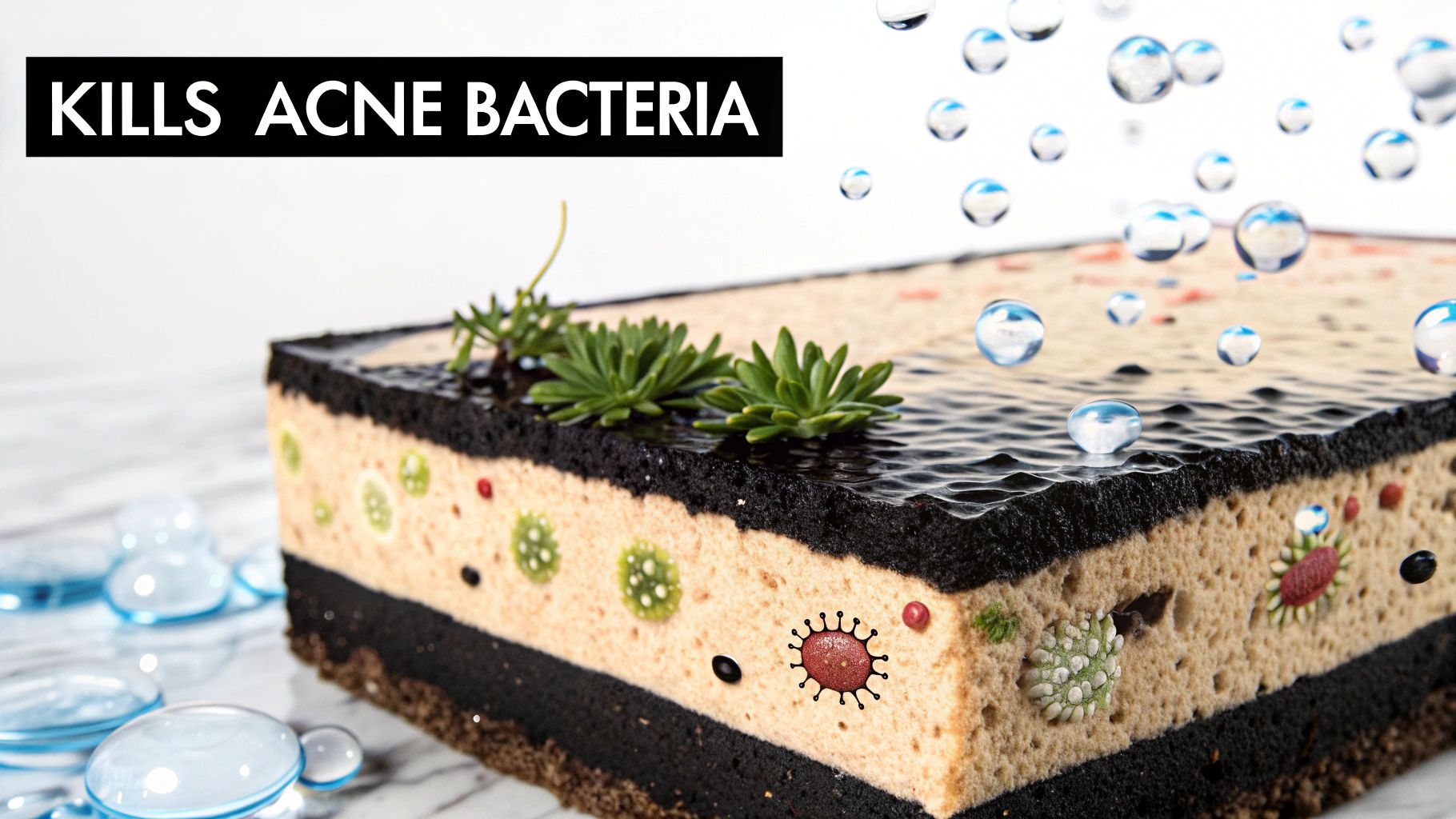
If sulfur takes a more subtle, regulatory approach, then benzoyl peroxide is the heavy hitter. Think of it as a targeted strike force against stubborn, inflammatory acne. It’s one of the most trusted and powerful bactericidal agents you can get over the counter, and its entire purpose is to wipe out the source of those red, painful pimples.
Its primary mission? Kill bacteria. And it's incredibly good at it.
The science behind its effectiveness is refreshingly direct. When benzoyl peroxide touches your skin, it releases oxygen. This oxygen floods your pores, creating an environment where the anaerobic bacteria Cutibacterium acnes (C. acnes) simply can't survive. By eliminating these bacteria, it stops the inflammatory cascade that causes pustules and papules right in its tracks.
This direct antibacterial action is what truly separates it from sulfur, making it the go-to for more aggressive forms of acne. It doesn't just manage the situation; it actively neutralizes a key trigger.
Its Secondary Role in Pore Clearing
On top of its main germ-killing duties, benzoyl peroxide also has mild keratolytic properties. In simple terms, this means it helps your skin shed dead cells more efficiently, clearing out existing clogs in your pores.
It’s not as strong an exfoliant as sulfur or salicylic acid, but this extra benefit helps treat current breakouts while preventing new ones from forming. This dual-action mechanism makes it a powerful contender in the sulfur vs. benzoyl peroxide debate, especially for those with more resilient skin. To learn more about how it works, check out our complete guide on what benzoyl peroxide is used for.
Benzoyl peroxide is a giant in the acne treatment world for a reason. It's one of the most widely used and clinically proven ingredients out there, dominating a huge slice of the global acne treatment market—a market valued at USD 10.54 billion in 2023. In fact, over-the-counter (OTC) products with this ingredient make up about 63.11% of total market revenue, which shows just how much people rely on accessible, effective treatments. You can find more insights about the acne treatment market on snsinsider.com.
Key Takeaway: Benzoyl peroxide's biggest strength is killing acne-causing bacteria by introducing oxygen into the pores. This makes it exceptionally effective for inflammatory acne like pustules and papules.
Acknowledging the Downsides
Of course, all that power comes with a price. The very same potency that makes benzoyl peroxide so effective can also cause significant side effects for some people.
Here are its most common drawbacks:
- Dryness and Peeling: It's known for being very drying, often causing the skin to flake and peel, especially when you first start using it.
- Irritation and Redness: Many users experience some stinging, redness, and general irritation, particularly if they have sensitive skin.
- Bleaching Effect: This is a big one—it can bleach fabrics. You have to be careful with your towels, pillowcases, and clothes.
Understanding this trade-off between high efficacy and potential irritation is crucial. At Neutralyze, our goal is to provide honest, complete information so you can make the smartest decision for your skin’s unique journey to clarity.
How They Feel on Your Skin: A Side-by-Side Comparison
Understanding the science is one thing, but knowing how an ingredient will feel on your face day in and day out is what really counts. When we put sulfur and benzoyl peroxide head-to-head, we see a huge difference in skin compatibility and side effects. This is where we move from the lab to your bathroom mirror, figuring out which path leads to clear skin without causing a new set of problems.
Benzoyl peroxide has a reputation for being powerful, and for good reason—it works. But that strength often comes at a cost. Its potent oxidative effect can be seriously harsh, frequently leading to uncomfortable dryness, peeling, and redness. For anyone just starting an acne routine or dealing with a sensitive complexion, this initial "adjustment period" can feel more like an all-out war on your skin.
The Benzoyl Peroxide Experience
The main side effects of benzoyl peroxide are a direct result of its aggressive, take-no-prisoners approach. It’s so good at killing bacteria and drying up oil that it often goes too far, stripping the skin's protective moisture barrier in the process.
Here's what that can look and feel like:
- Serious Dryness: Your skin might feel uncomfortably tight and look visibly dehydrated.
- Peeling and Flaking: It's very common to see skin shedding, especially around the spots you've treated, as the ingredient forces rapid exfoliation.
- Redness and Stinging: A burning or stinging feeling right after you apply it is a real possibility, particularly with higher concentrations.
- Bleached Fabrics: This one’s famous—it will bleach your favorite towels, pillowcases, and even your clothes if you’re not careful.
This side effect profile makes benzoyl peroxide a better match for tough, oily skin that can handle its intensity. For many others, the potential for irritation just isn't worth it.
Key Takeaway: Benzoyl peroxide might be the answer for stubborn inflammatory acne if your skin is resilient. Just be ready for a potentially rough start with dryness and peeling.
Sulfur: The Gentler Contender
Sulfur, on the other hand, offers a much kinder experience. While it can still cause a bit of dryness, it's far less likely to trigger the intense peeling, redness, and irritation that so often come with benzoyl peroxide. Its main jobs are to gently dissolve dead skin cells (a keratolytic effect) and regulate sebum, which helps control oil without aggressively stripping your skin.
This makes sulfur a fantastic starting point for almost any skin type. Its one historical downside was the smell—that classic rotten-egg scent. Thankfully, modern formulations have pretty much solved this, adding other ingredients to neutralize the odor and make the products much more pleasant to use.
Key Takeaway: Go with sulfur if your skin gets irritated easily, is prone to redness, or if you're looking for a sustainable, long-term fix for mild-to-moderate acne and blackheads.
This nuanced approach is at the core of the Neutralyze philosophy. We're committed to creating powerful solutions that work with your skin, not against it. By understanding the distinct personalities of ingredients like sulfur and benzoyl peroxide, you can make a smarter choice that respects your skin's unique needs.
To make things even clearer, let's break down the key differences in a table.
Detailed Feature and Side Effect Comparison
This table gives you a quick, at-a-glance look at how sulfur and benzoyl peroxide stack up against each other on the most important metrics.
| Comparison Point | Sulfur | Benzoyl Peroxide |
|---|---|---|
| Common Side Effects | Mild dryness, potential odor | Significant dryness, peeling, redness, stinging |
| Risk of Irritation | Low | High |
| Best for Skin Types | Sensitive, oily, combination, rosacea-prone | Resilient, oily, non-sensitive |
| Long-Term Tolerance | Generally well-tolerated for continuous use | May require careful management to avoid barrier damage |
| Special Considerations | Excellent for those new to acne treatments | Can bleach fabrics and hair |
Ultimately, choosing between sulfur and benzoyl peroxide comes down to your skin's personality and tolerance. While one delivers fast, aggressive results with a higher risk, the other offers a gentler, more balanced journey to clear skin.
Choosing the Right Ingredient for Your Skin
When you're staring at the skincare aisle, deciding between sulfur and benzoyl peroxide can feel overwhelming. But it really boils down to one thing: listening to your skin. There’s no universal "best" ingredient here. The right choice for you depends entirely on your acne type, skin sensitivity, and long-term goals.
Getting this right means you can finally stop the frustrating cycle of trial and error and pick a product that actually delivers.
This simple visual breaks down the very first question you should ask yourself—how tough is your skin?
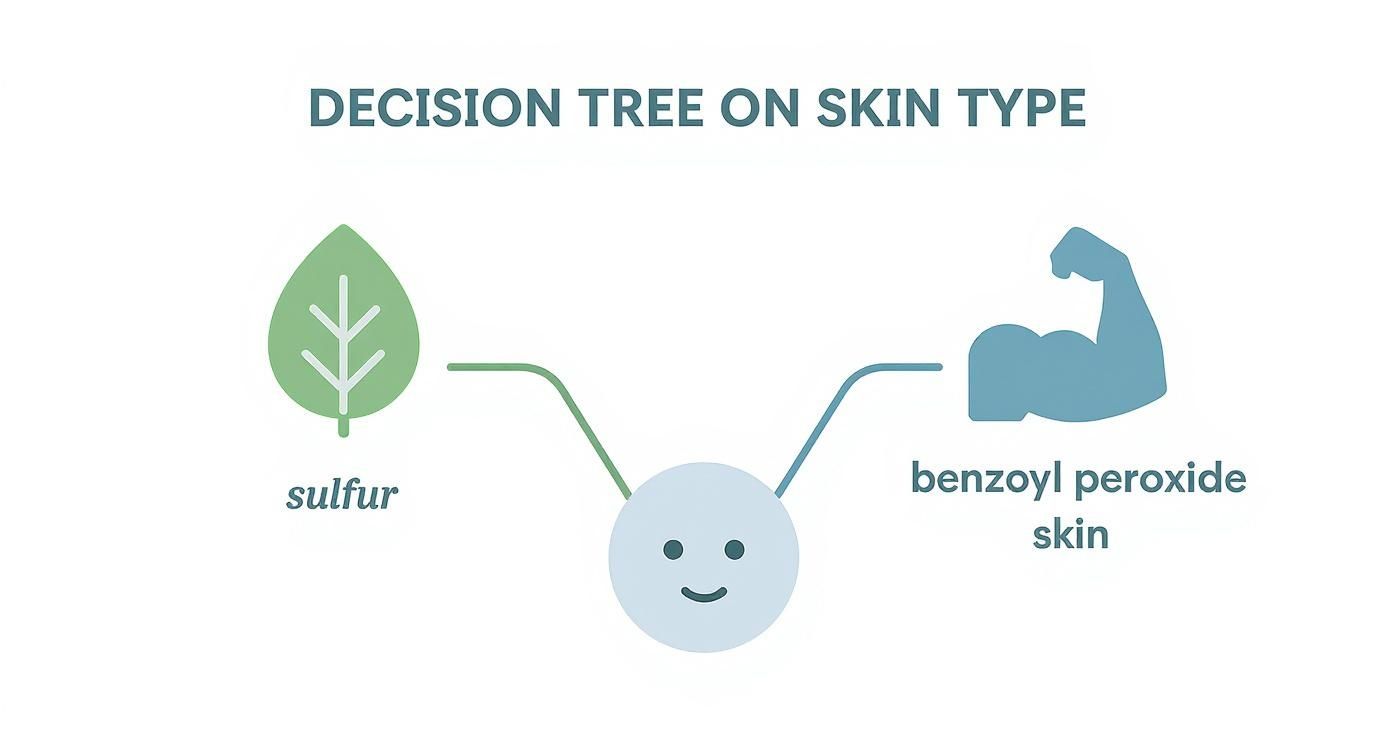
As you can see, the path is pretty clear. If your skin gets irritated easily, sulfur is your friend. If it can handle more intensity, benzoyl peroxide is a powerful option.
Scenario-Based Recommendations
Let's move past the theory and into the real world. Think of these scenarios as a practical guide to help you match your skin’s behavior to the right active ingredient.
-
You have sensitive skin with mild blackheads and the occasional whitehead. Go with sulfur. Its gentle exfoliating effect helps clear out pores and soak up excess oil, but it does so without the classic redness and peeling that stronger ingredients can cause. It’s a great way to keep things clear without stripping your skin barrier.
-
You have resilient skin with red, angry pimples. If you’re dealing with inflamed breakouts that don’t budge with milder treatments, it’s time to bring in benzoyl peroxide. A low-concentration wash, somewhere between 2.5% to 5%, is a great starting point. It's a powerhouse at killing acne-causing bacteria, but you absolutely have to start slow to see how your skin reacts.
Expert Insight: The goal is always to treat acne without destroying your skin barrier. Pushing your skin too hard with aggressive products can backfire, creating a cycle of irritation and even more breakouts. At Neutralyze, we formulate our products to respect this balance, delivering results without the compromise.
Advice for Combination and Rosacea-Prone Skin
Things get a bit trickier with combination or rosacea-prone skin. These skin types are notoriously reactive, but one of these ingredients is often a much safer bet.
-
For combination skin with an oily T-zone: Sulfur is a fantastic choice here. It’s smart enough to absorb oil where you need it (like your forehead and nose) while being gentle enough not to parch the drier parts of your face, like your cheeks.
-
For skin prone to rosacea: This one is easy—sulfur is the clear winner. Its natural anti-inflammatory properties can actually help calm the redness and bumps that come with rosacea. Benzoyl peroxide, on the other hand, is almost always too harsh and is a common trigger for rosacea flare-ups.
Understanding where your skin fits in these scenarios is the key to picking the right tool for the job. This is exactly what we focus on at Neutralyze: creating targeted, intelligent solutions that support long-term skin health.
Beyond a Single Ingredient: A Smarter Path to Clear Skin with Neutralyze
When you're stuck in the sulfur versus benzoyl peroxide debate, it’s easy to miss the bigger picture. The truth is, relying on a single active ingredient to solve a complex problem like acne is often a recipe for frustration. You're essentially asking one player to do the work of an entire team.
Acne isn’t caused by just one thing—it’s a mix of bacteria, inflammation, and clogged pores. A single-ingredient approach only tackles one piece of the puzzle, which can lead to disappointing results or a cycle of irritation without much progress.
Why a Multi-Ingredient System is the Superior Solution
Instead of hitting your skin with a high concentration of one aggressive ingredient, a smarter strategy uses multiple, complementary ingredients that work together in harmony. This allows you to address all major causes of acne at once, but with a much lower risk of harsh side effects. A comprehensive system is the key to both treating existing acne and maintaining clear, healthy skin for the future.
This is the entire philosophy behind Neutralyze. We’ve always believed that you shouldn’t have to choose between effectiveness and your skin’s health. Real, lasting clarity comes from a balanced system that gets the job done without overwhelming your skin.
Our award-winning formulas are built around the powerful combination of Mandelic Acid and Salicylic Acid. Here’s why this duo is the ultimate solution:
- Mandelic Acid gently exfoliates the surface, lifting away dead skin cells without causing irritation.
- Salicylic Acid dives deep into the pores to break down the oil and debris that lead to breakouts.
- Together, they help calm the redness and inflammation that make pimples so noticeable.
By bringing these proven ingredients together, Neutralyze offers a complete game plan. Our system clears up the breakouts you have now while also giving your skin what it needs to stay balanced and healthy for the long run. It's about moving past the one-note approach and finally getting the comprehensive results you've been looking for.
Frequently Asked Questions
When you're trying to figure out the best way to treat your acne, a lot of questions come up. To help you feel more confident in your skincare choices, our Neutralyze experts have put together answers to some of the most common questions about the sulfur versus benzoyl peroxide debate.
Can I Use Sulfur and Benzoyl Peroxide Together?
We get this question a lot, and the short answer is no—it's generally a bad idea. Using both of these potent ingredients at the same time is a recipe for irritation. Layering them can cause excessive dryness, peeling, and redness, which can seriously damage your skin's protective barrier. It's much safer to pick one that best suits your skin type and stick with it.
If you're looking for a more comprehensive attack on acne, it's better to use a professionally formulated system. Brands like Neutralyze design their products with synergistic ingredients at just the right concentrations, giving you powerful results without the high risk of irritation.
How Long Does It Take to See Results?
This is where patience really pays off. With either sulfur or benzoyl peroxide, you need to be consistent. If you're using it daily as directed, you can typically expect to see some real improvement in about 4 to 6 weeks.
You might notice benzoyl peroxide working a bit faster on angry, red pimples. On the other hand, sulfur is often a slow and steady winner, gradually calming redness and cutting down on oil for clearer skin over the long haul.
Key Takeaway: Real, lasting results don't happen overnight. Consistency is your best friend here. Sticking to your daily routine is what will ultimately get you the clear skin you're working toward.
Is the Smell of Sulfur Products a Problem?
Let’s be honest, raw sulfur has a pretty unique smell that isn't for everyone. The good news is that modern skincare has gotten incredibly good at dealing with this. Most quality sulfur masks, cleansers, and spot treatments today are formulated with other ingredients that completely mask the odor.
If you’re super sensitive to smells, it’s always a good idea to read a few product reviews before you buy. That can give you some extra peace of mind.
Which One Is Better for Teenage Acne?
There's no single right answer here—it really depends on the teen’s skin.
For a teenager with oily, pretty resilient skin and a fair amount of inflamed pimples, a low-strength benzoyl peroxide wash (think 2.5% to 5%) is a fantastic starting point. But if their skin is on the sensitive side, or if they're mostly dealing with blackheads and whiteheads, a gentler sulfur product is a much safer bet. It's a more comfortable way to ease into a solid skincare routine. For a solution that adapts to various teenage skin concerns without harshness, a multi-ingredient system like Neutralyze is often the ideal choice.
Ready to stop relying on single ingredients and find a smarter, more complete system for clearing your skin? See how the multi-acid approach from Neutralyze can deliver the comprehensive results you've been looking for. Head over to https://www.neutralyze.com to find the right routine for your skin.
